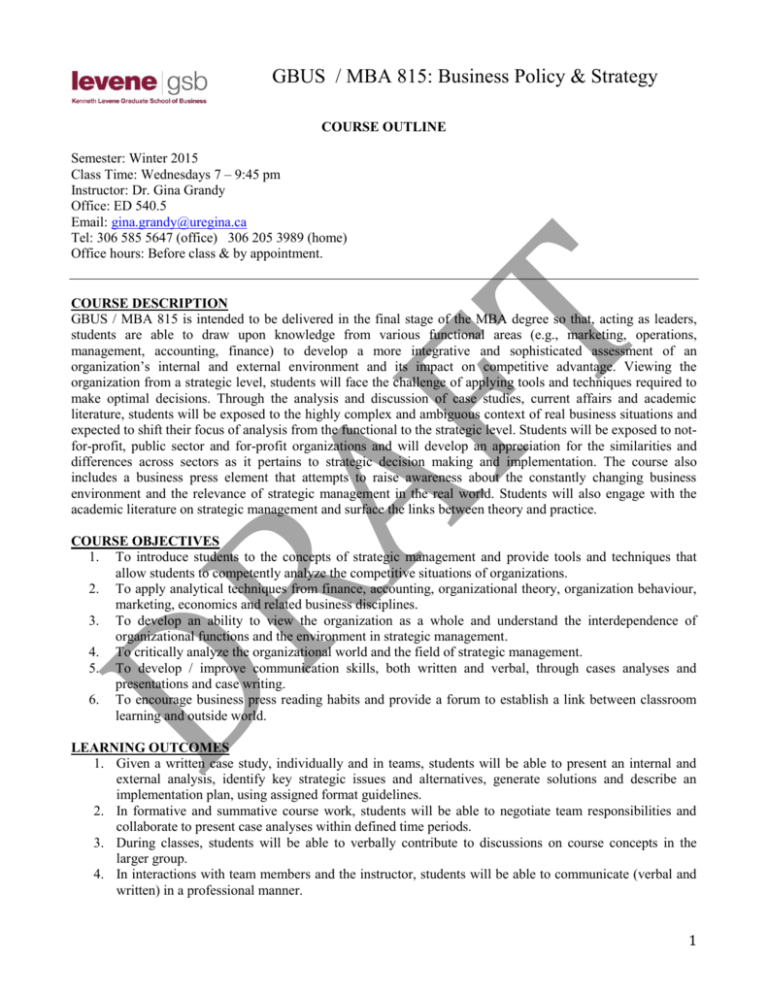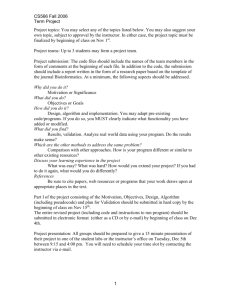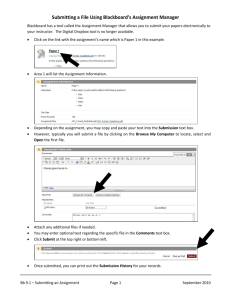GBUS / MBA 815: Business Policy & Strategy
advertisement

GBUS / MBA 815: Business Policy & Strategy COURSE OUTLINE Semester: Winter 2015 Class Time: Wednesdays 7 – 9:45 pm Instructor: Dr. Gina Grandy Office: ED 540.5 Email: gina.grandy@uregina.ca Tel: 306 585 5647 (office) 306 205 3989 (home) Office hours: Before class & by appointment. COURSE DESCRIPTION GBUS / MBA 815 is intended to be delivered in the final stage of the MBA degree so that, acting as leaders, students are able to draw upon knowledge from various functional areas (e.g., marketing, operations, management, accounting, finance) to develop a more integrative and sophisticated assessment of an organization’s internal and external environment and its impact on competitive advantage. Viewing the organization from a strategic level, students will face the challenge of applying tools and techniques required to make optimal decisions. Through the analysis and discussion of case studies, current affairs and academic literature, students will be exposed to the highly complex and ambiguous context of real business situations and expected to shift their focus of analysis from the functional to the strategic level. Students will be exposed to notfor-profit, public sector and for-profit organizations and will develop an appreciation for the similarities and differences across sectors as it pertains to strategic decision making and implementation. The course also includes a business press element that attempts to raise awareness about the constantly changing business environment and the relevance of strategic management in the real world. Students will also engage with the academic literature on strategic management and surface the links between theory and practice. COURSE OBJECTIVES 1. To introduce students to the concepts of strategic management and provide tools and techniques that allow students to competently analyze the competitive situations of organizations. 2. To apply analytical techniques from finance, accounting, organizational theory, organization behaviour, marketing, economics and related business disciplines. 3. To develop an ability to view the organization as a whole and understand the interdependence of organizational functions and the environment in strategic management. 4. To critically analyze the organizational world and the field of strategic management. 5. To develop / improve communication skills, both written and verbal, through cases analyses and presentations and case writing. 6. To encourage business press reading habits and provide a forum to establish a link between classroom learning and outside world. LEARNING OUTCOMES 1. Given a written case study, individually and in teams, students will be able to present an internal and external analysis, identify key strategic issues and alternatives, generate solutions and describe an implementation plan, using assigned format guidelines. 2. In formative and summative course work, students will be able to negotiate team responsibilities and collaborate to present case analyses within defined time periods. 3. During classes, students will be able to verbally contribute to discussions on course concepts in the larger group. 4. In interactions with team members and the instructor, students will be able to communicate (verbal and written) in a professional manner. 1 5. Given guidelines, individually or in teams, students will interact with representatives from an organization of their choice and collect primary and secondary information to write a case study on a strategic decision facing that organization. 6. In a take-home exam format, students will be able to list, describe and apply course concepts in response to case and essay-style questions and demonstrate critical thinking. 7. In lectures, seminars, case analyses and exam students will be able to identify and discuss (verbal and written) similarities and differences in the theory and application of strategy concepts across different sectors (e.g., health care versus manufacturing) and types of organizations (e.g., nonprofits versus for profits versus SMEs). TEXT / MATERIALS 1. Dess, G., Lumpkin, G., Eisner, A., and Perdis, T (2012). Strategic management. Creating competitive advantage. 3rd Canadian Ed. McGraw-Hill Ryerson. 2. Readings & Cases – provided by instructor, accessed through library resources, posted on UR Courses and to be purchases through Ivey & Harvard Publishing. a. Students can expect to purchase 5 – 8 cases 3. Class slides will be posted in advance of class on UR Courses. SPECIAL NEEDS If there is any learner who, because of a disability, may have a need for accommodation(s), please discuss this with the instructor and / or contact the Coordinator of Special Needs Services at 585-4631. WRITING ASSISTANCE The Student Success Centre (www.uregina.ca/ssc) offers both on-line resources and in-person tutoring on writing skills. COURSE REQUIREMENTS This course includes lectures, case discussions, videos and experiential exercises. As a result, regular attendance in class and active participation in classroom activities are required. Students are expected to be comfortable with ALL material discussed in class (not just textbook content). Lecture content will go beyond the coverage in the textbook. It is expected that students will read and prepare appropriately for every class. If a student is unprepared for a class 1 mark will be taken off her participation grade for the course (this will occur in every class that the student is not prepared). Please read each section of the course outline for expectations on all components of the course. Throughout the course linking theory and practice discussions will occur. Students are expected to read local, national and / or international newspapers and discuss in class how the newsworthy event relates (or not) to content discussed in class. This will serve as an important aspect of participation grades. In this course you will be encouraged and expected to engage in critical thinking. This will surface in class discussions and the assigned readings. You will be rewarded for demonstrating critical thinking in your informal and formal assessment exercises throughout the course. For this course, critical thinking is defined as an ongoing process of active and reflective learning. It involves surfacing our underlying beliefs about concepts and experiences and questioning why we ‘see’ it in this way. It also involves exploring how other individuals, groups and disciplines might ‘see’ these concepts. Through this process we develop an appreciation for multiplicity, difference, ambiguity, contradiction and new ways of understanding and being. Students will be required to work in groups for a case presentations. The whole team will be held responsible for the team’s success or failure. Group size will be a function of final course enrolment. Students must sign up for groups in Class 2 Jan 14. Teams must include a ‘numbers’ person (e.g., accounting, finance, economics), ‘marketing’ person, AND management or general person. The instructor will attempt to accommodate the students’ preferences, however, she reserves the right to select teams if necessary (for a variety of reasons). 2 Use of laptops, cell phones, recording devices in class. Laptops can be used UNTIL misuse is suspected in class. If it is suspected that any one individual is using a laptop to check email, search the web, etc. instead of taking notes, ALL laptop use could be banned from class. No cell phones in class – no ringing or playing with phones. Recording devices – no recording of class lectures. Slides will be available to students in advance of class – listen and engage with the material being presented and take notes based upon that. Exceptions to this will be considered if the student makes an appointment and meets with the instructor to discuss the reasons. Academic Ethics. Students are reminded that they must adhere to the standards of ethics of the university (see Section on Academic Conduct and Misconduct Regulations Governing Discipline for Academic and Nonacademic Misconduct in the Academic Calendar). Students must appropriately reference material and must submit their own work. If unethical behaviour is suspected, all individuals involved will receive zero on this component of the course. GRADING The following grading system will be used in assigning marks. A+ A AB+ B F 90% + 85 – 89.99% 80 – 84.99% 75 – 79.99% 70 – 74.99% Less than 70 % Grade Allocation Individual Short Case Submissions (best 2 of 3 submissions) Individual (or Team) Written Case Study Team Case Analysis (presentation *or* presentation & report) Final Exam (take home) Peer Evaluation (for the team case analysis) Participation Total 10 - 20% 15 - 30% 15 - 30% 20 - 30% 5% 10% 100% You can choose within the ranges provided to have some ‘say’ in how marks are allocated across course components. Grade profiles (posted on UR Courses) are due January 14, 2015, after that date *no changes* can be made to the grade allocation. If you prefer to take the default allocation, it is as follows: Individual Short Case Submissions 15%, Individual (or team) Written Case Study 15%, Team Case Analysis 25%, Final Exam 30%, Peer Evaluation 5% and Participation 10%. COURSE COMPONENTS Individual Short Case Submission (best 2 out of 3) Students will be assigned questions on case studies and answers are to be submitted at the beginning of the class on which the submission is due. The submissions are to be 2 - 3 pages in length (single spaced and typed) and can be submitted in bullet point format (or using tables, etc.) as long as the content provided is of sufficient depth. Questions to be answered for each submission will be posted to URCourses. NOTE: These are individual submissions and no collaboration among students is permitted. Please submit with student ID only. 3 Individual Case Submission #1. Due at the start of class Week 2. Jan. 14. Individual Case Submission #2. Due at the start of class Week 4. Jan 28. Individual Case Submission #3. Due at the start of class Week 5. Feb 4. Team Case Analysis (Presentation or Presentation & Report) In teams of 3 – 5 students will perform a strategic analysis and recommendations for an assigned case on either Mar. 11 or Mar. 18. Teams can choose to submit a written report and deliver a presentation OR deliver a presentation only (if the team selects to deliver a presentation only, all marks allocated to this component of the course will be based upon the presentation). The presentation is to be of 20 mins in duration. It is important that teams are comprised of members from all of the functional areas. Teams *should* include a ‘numbers’ person, a marketing person and a management (or general) person. It is expected that students present in a professional manner (i.e., dress, behaviour). Every member of the team must play a significant role in the preparation and execution of the presentation in order to receive a grade. The in-class presentations will occur in Week 9 (Mar. 11) & Week 10 (Mar.18). Presenting teams will assume the role of the consultant. Grading of the full case presentation will be based upon the conciseness and clarity of the presentation, number of major issues and problems addressed, accuracy of the analysis, depth of analysis, soundness of arguments used to support recommendations and implementation plan, and the ability to address questions (~ 10 mins). The marking template and other guidance will be made available to students. IMPORTANT: You must provide the instructor with a copy of slides at the time of presentation (handouts – 3 per page). Individual (or team) Written Case Study Individually or in teams of 2 – 3, students will conduct primary (e.g., interviews) and secondary (e.g., corporate documents, Statistics Canada) research to write a case study highlighting a strategic management decision on an organization of their choice. In addition, students must include a statement of teaching focus (suggested themes / links to theory / learning objectives), as well as develop and answer three questions that could be used to guide discussion if the case was used as a learning tool – this is to make clear the strategic management concepts that the case is intended to illustrate. The case site can be a not-for-profit, charity, public sector or for-profit organization (MNC or SME). The submission is due in-class on April 8 and in class students will provide a short summary of the case and key take-a-ways. Case writing guidelines, suggestions and assessment guide will be discussed further in class to assist students in this process. The submission must Have the case site approved by the instructor. Comprise of 5 to 6 pages in length for the main text (single spaced 12 Times Roman font) plus exhibits plus statement of teaching focus / questions for discussion Have a clear decision focus which is at the strategic level (at the beginning of the case & end) Have a clearly identified decision maker Include the real name of the organization and key decision maker Have a clear time frame that is within the last year and preferably within the time frame of the course (this should include the timing of the case and the period in which a decision must be made) Develop key characters (more than 1 interview should be conducted & include direct quotes) 4 Use secondary data for up-to-date industry / external / competitor / consumer trends with references included (as endnotes) (4 – 6 sources) Have a completed case release form signed by the organization and all interviewees (which will indicate that the case may be further developed for publication at a conference or other scholarly source) – this will provided in class Focus on one of the following themes (some of these will require the students to read ahead in course material) o Growth or retrenchment (corporate level strategy) o Positioning (business level strategy – NOT marketing) o External Environment analysis o Internal Environment analysis o Mission o Strategic Planning o Strategic Change o Strategy Implementation o Competitive Advantage o Governance o Shared Value o Or other topic if approved by instructor Other considerations for inclusion: Relevant financial data (the extent of financial information necessary will depend upon the case focus – you may want to check if the organization is willing to provide you with financials to share publicly before deciding upon the organization and the focus of your case). Video of key decision maker discussing the situation as a supplement to the case. Key dates. Confirmation of the case site and approval by the instructor by Week 7 February 24. Outline / draft of case (with at least one completed interview) to instructor for discussion by Week 11 March 25. Case & Statement of Teaching Focus, Discussion Questions & Answers (and short in class presentation) Due Week 13 April 8. FINAL EXAM There will be a take-home final exam in this course. It will be comprehensive in nature and could include some combination of case analysis and theory / practice essay style questions. Additional details will be provided in class (formatting, structure). It is due during exam period Wednesday April 22 at 7 pm. PEER ASSESSMENT (on team case analysis, *not* written case study project) 5% All members of a team will be required to submit a team assessment that will include assessment of each team member’s performance in the case analysis project (not the written case). This will be discussed in further detail in class and it is due Week 11 Mar 25. PARTICIPATION 10% Participation will be graded on the value of the contribution to class, rather than solely on the number of times one participates. It is essential that students are present for all classes, however, it is not enough to simply come to class, students must be active participants in class. To receive enough points to get a passing participation grade a student must participate regularly in class discussion. To do this one must come to class having prepared for the topic under discussion. In addition, there will be times throughout the course that informal team presentations will occur and will form part of the participation grade. 5 An automatic grade reduction may be applied if you are not prepared to discuss the assigned topic for the day. Attendance and participation is the responsibility of the student, if you expect to miss class, etc. it is your job to inform the instructor. This will form 10% of the final grade. SCHEDULE The schedule of classes will be posted to URCourses. It should be noted that the schedule of classes may be altered slightly to accommodate current events or to incorporate any interesting material deemed relevant by the instructor that might come up at a later date. 6





